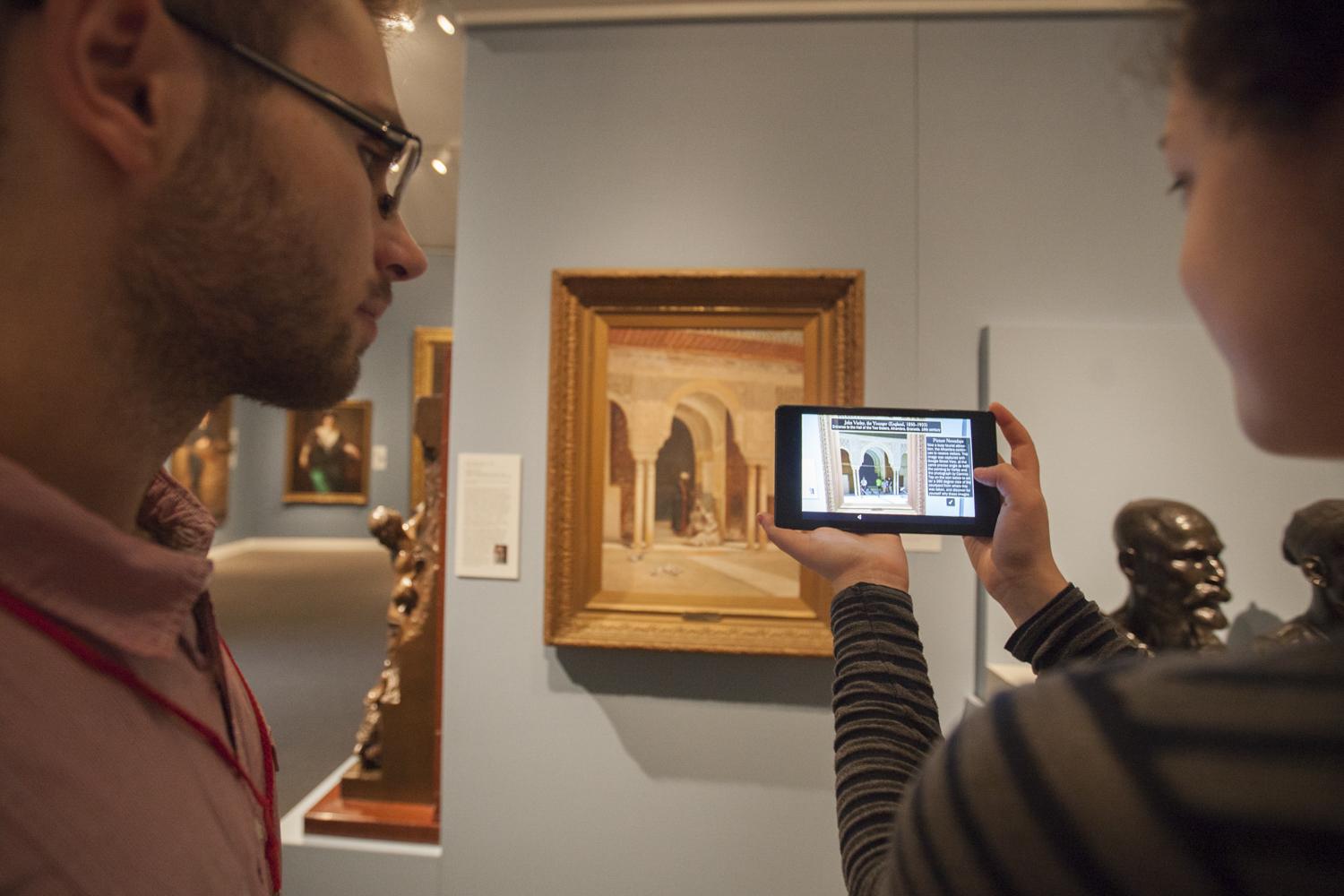Art++ Technology and Art Lab
July 13 through September 26, 2016
Stanford, California—The Cantor Arts Center at Stanford University and the Brown Institute for Media Innovation are pleased to announce the launch of Art++, an augmented reality (AR) mobile app created for art museum visitors. Heralded as the cutting edge of media, augmented reality refers to any technology that superimposes graphics onto a user’s normal field of vision, often through a camera viewfinder or headset. The app’s release coincides with the July 13 opening of Art++ Technology and Art Lab, a Cantor exhibition that showcases the capabilities of Art++ by featuring artwork that visitors can explore through augmented reality.
As technology has an increasing presence in our daily lives, museums are investigating new ways for digital innovation to enrich our firsthand encounters with art. At Stanford, the idea for Art++ came about after a conversation between former Cantor Director Connie Wolf and Professor Bernd Girod, Founding Director of the Brown Institute for Media Innovation. (The Brown Institute is housed jointly at Stanford’s School of Engineering and Columbia’s Graduate School of Journalism in New York.) With a Magic Grant from the Brown Institute, the Art++ Initiative was launched in the summer of 2014. The exhibition Art++ Technology and Art Lab is the culmination of this two-year effort.
All Art++ content is based on three AR experiences: overlays, panoramas, and series. The Art++ Technology and Art Lab installation features objects ranging from a 17th-century Dutch landscape painting to a 20th-century Nigerien textile that were chosen specifically for their capacity to highlight Art ++. The AR graphics can provide the user with insight into the long and complex history of an image, explain the processes involved in art conservation, or even offer a panoramic view of an actual site replicated in an image.
The Art++ Initiative presents new opportunities to meld Stanford’s world-class engineering research with its flourishing arts scene. In turn, the Cantor exhibition Art++ Technology and Art Lab provides a glimpse of what is possible when technology enhances the experience of viewing and enjoying art.
Software Release
The Art++ image recognition and augmented reality platform is available for use as open-source software. Please contact the team at artplusplus.stanford.edu for more information. The Art++ team will demonstrate the app at the Museum Computer Network (MCN) conference in New Orleans, November 1–4, 2016. The MCN is a global community of professionals who seek to use digital technologies to help fulfill the missions of their cultural organizations.
About the Brown Institute for Media Innovation
The David and Helen Gurley Brown Institute, housed jointly at the Stanford University School of Engineering and the Columbia University Graduate School of Journalism in New York, was established with a gift from Helen Gurley Brown, longtime editor of Cosmopolitan magazine, in memory of her late husband, David Brown. The institute funds projects that drive the cutting edge of media technology. Project funding from Brown usually supports teams of graduate students and postgraduates who are interested in creating or testing an innovative media prototype. The institute serves as an incubator for digital media technologies and is committed to supporting student projects in this field.
About the Art++ Team
Jean-Baptiste Boin is a Ph.D. candidate in the Department of Electrical Engineering at Stanford, advised by Professor Bernd Girod. His research interests lie in image retrieval and computer vision—in particular, augmented and virtual reality.
Skanda Shridhar recently graduated from Stanford University with an M.S. in electrical engineering. He is excited by the opportunity to work on a project in computer vision and signal processing.
Anna Toledano, Art++ copywriter and Ph.D. student in Stanford’s Department of History, is studying history of science. Prior to coming to Stanford, she worked in interpretation at the New York Botanical Garden, where she also produced content for mobile apps.
María del Carmen Barrios Giordano serves as Curatorial Assistant to the Art++ Initiative at the Cantor Arts Center. She graduated from Stanford with a B.A. in history and international relations in 2013.
Bernd Girod, the Robert L. and Audrey S. Hancock Professor of Electrical Engineering at Stanford University, serves as advisor to the Art++ technical team.
This exhibition is organized by the Cantor Arts Center in support of the Art++ Initiative, a project funded by a Magic Grant from the Brown Institute for Media Innovation.
Cantor Arts Center at Stanford University
Founded when the university opened in 1891, the museum was expanded and renamed in 1999 for lead donors Iris and B. Gerald Cantor. The Cantor’s collection spans 5,000 years and includes more than 38,000 works of art. Ranging from classical antiquities to contemporary works, the Cantor’s holdings include the largest collection of sculptures by renowned master Auguste Rodin in an American museum. With 24 galleries and more than 15 special exhibitions each year, the Cantor is one of the most visited university art museums in the country and is an established resource for teaching and research on campus. Free admission, tours, lectures, and family activities help the museum attract visitors from Stanford’s academic community, the San Francisco Bay Area, and from around the world.

